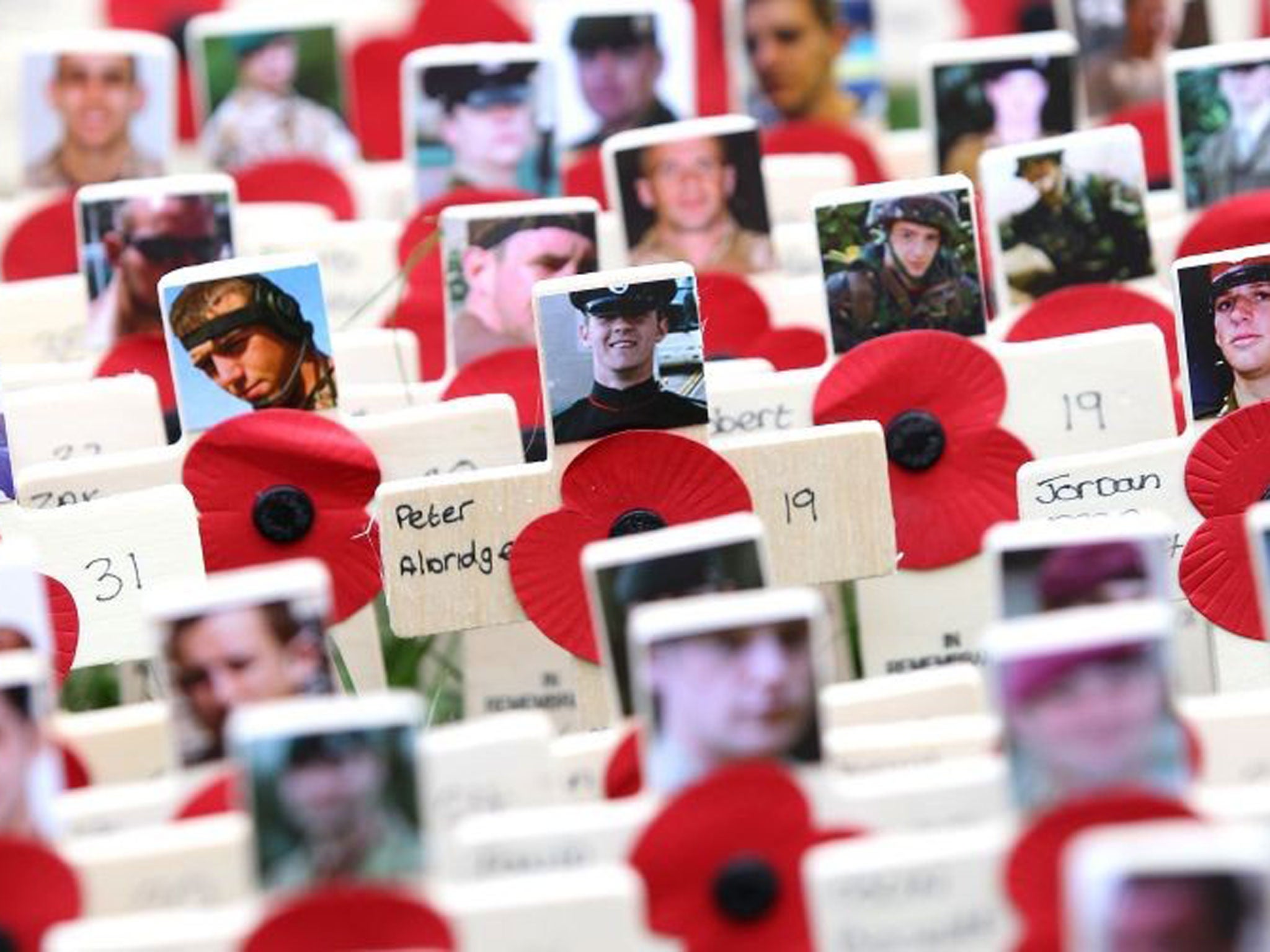Remembrance day: We remember, but we do not celebrate
In these memorials, the studied absence of triumphalism matters above all


No one who, on screen or stage, saw the late Richard Griffiths play the schoolteacher Hector in Alan Bennett’s The History Boys will easily forget the “Drummer Hodge” scene. One-to-one with his most responsive pupil, Posner, Hector explains Thomas Hardy’s poem about a teenage soldier of Wessex killed in the Boer War. “They throw in Drummer Hodge, to rest/ Uncoffined – just as found.” For Hector, who tells Posner about the anonymous bones swept up en masse from the battlefields of 19th-century Europe by a fertiliser firm (“in Yorkshire, of course”), Hodge’s individual identity matters most of all: “Lost boy though he is on the other side of the world, he still has a name.”
Except that he didn’t. At the time of Hardy’s poem, “Hodge” – as Bennett later acknowledged – simply meant any old country bumpkin: Joe Bloggs with a straw in his mouth. Even at the turn of the 20th century, Hardy can’t yet quite find a real person in the generic casualty of war, though a “portion of that unknown plain/ Will Hodge forever be”.
Two decades later, we not only knew the names of the dead. They had acquired a hallowed significance in the cult of sacrifice that took hold in Britain in the aftermath of the First World War. By the time that Reginald Blomfield’s Memorial to the Missing was inaugurated at the Menin Gate in Ypres in 1927, a decade of debate and agitation had settled into consensus about the art and rituals of remembrance. All agreed that the names of the lost should take pride of place. At Menin Gate, the Hall of Memory records 54,896 British and Empire troops to whom – in Rudyard Kipling’s words on the inscription – “the fortune of war” had denied “a known and honoured burial”. Edwin Lutyens’ grander Thiepval monument to the missing lists 72,191. Even if they lacked a grave, the Hodges filed name by name though the national consciousness, a legion of troubling ghosts. They are still tramping through our lives.
To the poet and Western Front survivor Siegfried Sassoon – one of the authors whose sorrow, rage and pity did so much to fix later attitudes to the Great War – the Menin Gate was no more than a “sepulchre of crime”. In this respect, the poet’s view has not prevailed. Even people who accept the now orthodox verdict on 1914-1918 as a genocidal folly in which the vain, deluded old men of a doomed ruling class “slew half the seed of Europe, one by one” (Wilfred Owen’s words) still find themselves touched by memorials.
Why? The studied absence of triumphalism matters above all. The British architecture of remembrance does not, as a rule, celebrate victory. Neither does it trade in windy patriotic abstractions. From Ypres to the smallest of the 54,000-odd subscription-raised local war memorials in Britain, it identifies and honours individuals. “Their name liveth for evermore”: Kipling, the literary architect of Great War memory in Britain, himself chose that phrase from the book of Ecclesiasticus as a standard inscription for “stones of remembrance”.
Another quality that has reconciled the war memorials to later, more sceptical generations is their strange sense of detachment from formal Christianity. Those “stones of remembrance” – Lutyens’ idea – have a severe, pagan monumentality, as does his still-mysterious Cenotaph in Whitehall. Look at it closely the next time you pass. In his intensely moving book Empires of the Dead, about Fabian Ware (the maverick journalist who kick-started the Imperial War Graves Commission), David Crane outlines the bitter battles between those who insisted that each marked grace should carry a cross and the architects who preferred a plain and non-denominational headstone. In British war cemeteries, the headstones – albeit inscribed with crosses – stand.
By 1914, the long-term drift away from religious observance in Britain had already begun. Post-war disillusion would accelerate it. In spite of the ardent faith of a figure such as Ware himself, the stoic, “Roman” and dogma-free style of the chief architects set the tone. Crane shows how this ban on overt religiosity upset many bereaved relatives. Grief-stricken Christian families bitterly resented the “secularised, democratic uniformity” of the cemeteries and memorials. Yet those very attributes have sustained their appeal.
Uniformity, however, did not mean anonymity. The insistence on naming the dead – preserved in the ritual of reading a roll call of the fallen in schools and elsewhere – brings home the paradox that the age of industrial-scale slaughter has coincided with the age of mass democracy. Hodge and his successors died in hitherto unimaginable numbers. But at least we knew precisely who they were.
Lists of the lost have become a mainstay of memorial projects all around the world. In Prague, no part of the Jewish Museum leaves a stronger impression than the wall of the Pinkas Synagogue that carries the name of Czech Jews murdered in the Holocaust. (I looked for, and found, Franz Kafka’s sisters.) In Washington DC, the Vietnam Veterans Memorial – “a wall that heals” – records 58,195 US victims of the war on its black gabbro stone. In Buenos Aires, I wandered around the equally dignified name-encrusted slabs of the Malvinas Memorial. A local visitor, finding out that I came from Britain, had no desire to argue about the Falklands. Instead, he asked about Premier League clubs. At the time, I took that as proof that globalised football trumped militarised politics. Now, I think he was just being tactful.
The National Memorial Arboretum in Staffordshire features at its heart an armed-forces monument unveiled by the Queen in 2007. Its curved walls bear the details of more than 15,000 British personnel killed in action since 1945. It also hosts an annual “reading of the names”. Look at the list of conflicts in which they died and you see that the military circumstances remain as divisive as the bloodbaths of the Somme and Passchendaele. From Palestine and Malaya to Iraq and Afghanistan, the roster of battlegrounds can be interpreted as a litany of late-imperial overstretch, blunder, delusion and recklessness. Yet the classical sobriety of the design, and the simple carved presence of so many individuals, dissolves any urge to dissent.
It’s now almost a century since, in 1915, Fabian Ware with his Graves Registration Commission foresaw and then brought into being the solemn, even taciturn, architecture of commemoration. You might say that this is one British innovation that has spread around the world. Elegiac tribute, free of jingoism or even nationalism and with the names of the dead at its core, now governs the record of war.
Yet the wars go on, in undiminished numbers. And Britain, the country that thanks to the work of Ware and his colleagues pioneered the idea of remembrance without hatred or hubris, has at least since 1945 shown an unusual appetite for pursuing them. Does our dignified religion of sacrifice somehow make fresh belligerence likelier, or at least easier to contemplate, than the sort of vulgar chauvinism that expired on the banks of the Marne in 1914? Crane comments that Sir Frederic Kenyon, the British Museum director who after 1917 steered the Imperial War Graves Commission, managed to fashion “a picture of ordered sanity” out of “the psychic and physical mangling of a whole generation”.
In sites and in rituals, that ordered sanity endures. As ever, the mangling remains safely out of sight. Sometimes, war memorials can even achieve a kind of “cognitive dissonance” with two parallel narratives set, incompatibly, side by side. At the American Cemetery in southern Manila, over 17,000 graves of US forces – and their comrades from the Philippines – who died in the Pacific war of 1941-45 surround another sober set of name-inscribed walls. Yet each section of this noble monument also sports a multicoloured mosaic map. They depict every famous campaign, from Iwo Jima to Midway, in a blizzard of arrows, icons and symbols. The dimension of suffering and loss, so powerful on the greensward all around, has somehow vanished into nerdy diagrams of strategy.
Perhaps the names are no longer enough. Now, they may soothe more than they sting. Hence the recent hunger to hear the words of the final First World War survivors, fed initially by oral histories such as Max Arthur’s books, and then by the bittersweet twilight celebrity of the “last Tommies” such as Henry Allingham and Harry Patch. Frequently interviewed before his death aged 111, Private Patch said, repeatedly: “It wasn’t worth it. No war is worth it. No war is worth the loss of a couple of lives let alone thousands. The First World War, if you boil it down, what was it? Nothing but a family row.”
Thomas Hardy published “Drummer Hodge” late in 1899, when Harry Patch – more or less a child of Wessex himself – was a year old. Effectively, it took more than a century for the common soldier to acquire not just a stone, or a name, but a voice people heard. For many who remember this weekend, that will be their best memorial

Join our commenting forum
Join thought-provoking conversations, follow other Independent readers and see their replies